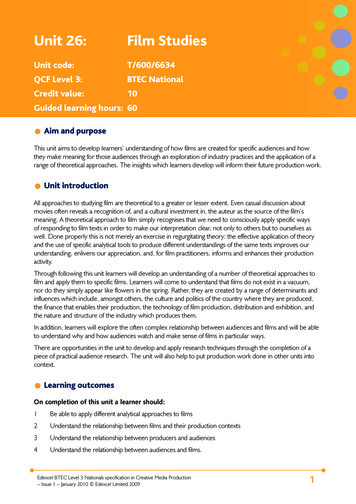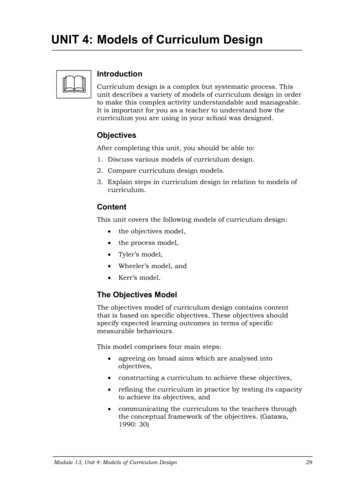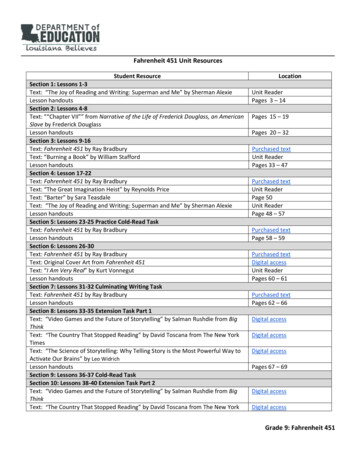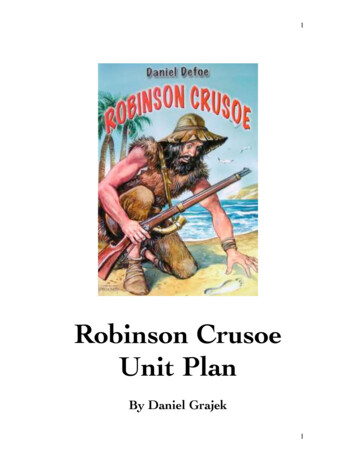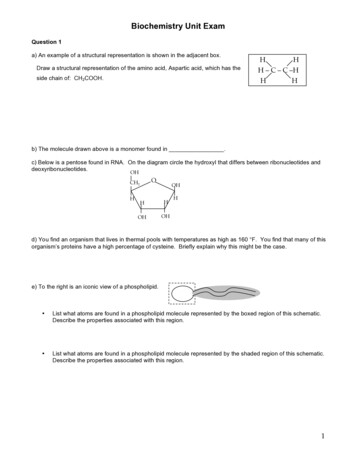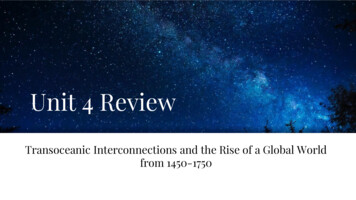
Transcription
Unit 4 ReviewTransoceanic Interconnections and the Rise of a Global Worldfrom 1450-1750
4.1 - TechnologicalInnovationsEssential Question: How did cross-cultural interactions spread technologyand facilitate changes in trade and travelfrom 1450 - 1750?2
Maritime TradeTrade had existed across land and water forcenturies, but as Europeans became moreinterested in the Indian Ocean trade networks,new patterns of trade began to develop. Europeans wanted to be involved in Indian Oceantrade but conflicts like the Omani-European rivalryencouraged European nations to finance expeditionslike Christopher Columbus’ in search of water routeseast. Omani European rivalry Portuguese tradingforts being challenged by locals.People like Prince Henry the Navigator encouragedmaritime exploration and trade. He paid for for expeditions along Africa’sAtlantic coast allowing Portugal to explorefurther than other European nations.The “discovery “of the new world by Columbus onbehalf of Spain encouraged other European nationsto fund water exploration and trade. This new pattern of long-distance trade andcolonization led to the rise of the MaritimeEmpires - empires based on sea travel andtrade rather than purely land expansion.3
InnovationsVarious technologies were taken or improved fromclassical Islamic and Asian technology allowingEuropeans to travel longer distances on the oceanthan ever before. Magnetic Compass - taken from China helped point aship in the right direction.Astrolabe - Taken from Muslim navigators this letsailors determine how far North or South they werefrom the equator.The Caravel - A small three masted ship developed bythe Portuguese made sailing rough seas easierCartography - Map MakingLateen Sail - Triangle sail that could catch the windfrom any direction allowing ships to sail on the ocean.New Ships: Carrack - Portugal - square and lateen sails Caravel - Portugal and Spain - Lateen sails Fluyt - Dutch - SquareNewton’s Ideas of Gravity - Increased knowledge oftidesAstronomical Chart - A map of the stars and galaxiesused for navigation4
Long-Term Results The long-term result of combining navigationaltechniques invented in Europe with those fromother areas of the world was a rapid expansionof exploration and global trade. The introduction of gunpowder aided Europe inthese expansions. Interactions among various cultures inside andoutside of Africa brought extensive trade andnew technology to Africa. The success of European nations encouragedplaces like Russia to consolidated and grow itsmilitary.5
4.2 - Exploration:Causes and EventsEssential Question: What were the causesand effects of the state-sponsoredexpansion of maritime exploration?6
4.2 - The Role of States in Maritime ExplorationCONTEXT: At the beginning of the 1400s, Italy controlled waterways between Europe and Asia, whichmeant they controlled the flow of goods between the two regions. This encouraged Spain, Portugal,France, and England to search for new water routes to Asia in search of riches, European dominance,and new places to spread Christianity (the three G’s - God, Glory, and Gold!) . European nations wereencouraged by Columbus’ “Discovery” of the New World. With the discovery ofgold and silver in faraway places, theeconomic policy ofMercantilism (sell morethan you buy to increaseyour wealth) droveEuropeans deeper intothe global explorationgame. No nation supported exploration as heavily as Portugal. Threepeople led: Prince Henry the Navigator - First European monarch tofinance sea travel in search of a all-water route to the East. Bartholomew Diaz - First to sail around the tip of Africa. Vasco da Gama - Sailed further East than Diaz, all the wayto India. Portuguese ports in India was the first step towardsthe creation of their trading post empire.7
4.2 - Portugal and Trading Post EmpiresPortuguese Dominance: In the early 1500s, Portugal hassuperior weapons and navigationaltechnology. Afonso de Albuquerque won a battleagainst Arab traders to win the Port ofMalacca (remember - this is like“buying the door” in the Indianocean!) Allowed them to dominate theIndian and African costs. Went to China: Didn’t change China much, butmissionaries followed. China didn’t like this andeventually close their doors totrade.Trading Post Empires: In order to ensure amonopoly in the IndianOcean trade, Portugal builtarmed trading posts aroundIndia and Africa. This made them thefirst trading postempire - an empirebuilt on trade ratherthan land. They didn’t haveenough people tocontrol lots of land!Restricted Indian ocean tradeto those willing to buy apermit!8Portuguese Vulnerability: Small nation lacking in workers. Corruption by merchants andgovernment officials. By 17th Century they had majorDutch and English rivals. Eventually, Portugal isoverpowered by the Englishin India and the Dutch inMalacca. They go to Japan and bringmissionaries, but like ChinaJapan closes their doors tothis trade.
4.2 - Spain in the Philippines and the Lure of Riches.While Portugal was the first Western European nation to reach the Indian Ocean by sea, Spanish ships were the first tocircumnavigate the globe with the expedition sponsored by Ferdinand Magellan. Spain annexed Manila near the Phillipinesand it became a Spanish commercial center, with many Filipinos becoming Christian. Spain was hooked on exploration!Europeans wanted to find awaterway to Asia mostly to findmore gold and silver (mercantilism) They almost gave up after theSpanish found so little!Soon, however, they came intocontact with Amerindians(Indigenous Americans) like the Incaand Aztec. This made exploration andcolonization profitable. Europeans quickly beganusing slave labor to growcrops and harvest valuablegoods.China: 9Quickly bought into the silver trade.Silver was transported on giantSpanish ships called galleons. In Manila, galleons tradedEuropean silver for Asianluxury goods. Galleons had a direct impacton the silver trade.The Chinese government soonshifted to a currency based on silver.Silver becomes a dominant force inthe global economy making placeslike Spain and Europe insanely rich!
4.2 - French ExplorationFrance started sponsoring expeditions in search of the Northwest Passage (waterway to East Asia andspices!) in the 1500s.Quebec:Jacques Cartier - Sailed from the Established Quebec as a FrenchAtlantic ocean to the northern US.fur trading post. Didn’t find a water-route to Missionaries tried to convertAsia, but did claim part ofNatives to Christianity.what is now Canada for The French rarely settledFrance. Eventually, France realizedpermanently.that there were lots ofresources in N. America andthey didn’t need to look for away to Asia anymore. France became heavilyinvolved in the furtrade. 10The French simply traded furstrapped by Natives to sell them.Had better relationships withNatives as a result.Settlements grew more slowlythat British counterparts.
4.2 - English ExplorationEngland also began searching for the Northwest Passage with explorer John Cabot. He claimed landsin the New World, but England was unable to defend themselves against the strong Spanish Armadauntil England shockingly defeated them in 1588. This established England as the dominate naval force inthe world.Jamestown: First English settlement in 1607. Settled first by joint stockcompanies, and later by thoseseeking religious freedoms.11
4.2 - Dutch Exploration The Dutch sent Henry Hudson to the East coast ofN. America in search of a Northwest Passage in1609. He didn’t find one, but he did sail upthe Hudson River (as it is known now).His explorations were valuable to the Dutch, andthey claimed the Hudson River Valley and theisland of Manhattan They called it New Amsterdam (NewYork City) This port was hugely prosperousbecause of its location near a majorriver flowing to the ocean.12
4.3 - Exploration: Causesand EventsEssential Question: What were the causesof the Columbian Exchange and itseffects on the eastern and WesternHemispheres?13
4.3 - Columbian ExchangeIn this new global world, the Eastern and Western Hemispheres shared not only goods, but diseases,foods, and animals in the Columbian Exchange.Diseases: Animals and Food: :Amerindians (Native Americans) had NO immunityto European diseases due tocenturies of isolation. This resulted in thedeaths of 50-90% of indigenous populationsdue to smallpox,measles, influenza, andmalaria. This is one of thegreatest populationdisasters in humanhistory.Food:Before the C.E., Native Americansate very little meat. Introduction of new meats likepigs and cows changedAmerican diets.The horse was also brought toAmerica Natives could hunt over largerareas leading to a surplus offood Hostile interactions alsoincreased between tribes. Food surplus allowed nativesto focus on art and spiritualitymore.14 Europeans took home corn,potatoes, tomatoes, beans,peppers, and cacao. Introduction of thesenew staple dietaryfoods resulted inmassive populationincreased in Europe.
4.3 - Cash Crops and Forced LaborAs cash crops begin to be produced in the new world, forced labor rises. African slaves brought okra andrice to the new world, while tobacco and cacao produced in the new world by slaves went to Europe.Sugar: : Spain focused on Silver in the new world,but Portugal focused on sugar. Sugar really kickstarts triangulartrade and the forced migration ofslaves into the new world. Sugar cultivation in Brazil requiredthe constant important of slavesfrom the Kongo and Swahili coast.The profitability of sugar encouragedSpain to focus its colonies on cash cropagriculture as well. Sugar soon eclipses silver as themain money maker for Europe inthe new world. Tobacco soonfollows.African Presence in the Americas: 15The forced movement of African people isknown as the African DiasporaLanguage - not able to transplant to thenew world. Some African languages werecombined with colonizer languageslike creole in the Southern US.Music - Came to the new world and wasused a means of survival under harshconditions. Kept spirits up and helpedenslaved Africans communicate.Food - Greatly influenced N. Americacuisine.
16
4.4 - Maritime EmpiresLink RegionsEssential Question: How were theempires of European states establishedbetween 1450 to 1750, and what economicand labor systems fueled them?17
Trading Posts in Africa and AsiaAFRICA: Trading posts were set up in Africa by the Portuguese and thenother European powers after Prince Henry the navigator traveled aroundAfrica. Some African rulers realized there was a military advantage toexchanging guns for slaves and grew wealthy You can see European influence in West African art which depictsEuropeans as “intruders” The Asante Empire and the Kingdom of the Kongo grew in influenceafter trade with Europe. The Portuguese takeover of ports on the Swahili coast threw theAfrican region into long term decline.JAPAN: Japan tolerated the Christian missionaries that came fromPortuguese and Dutch traders until the influence of Christianity grew toostrong. In 1587, the Japanese government banned Christian worship. By 1630, foreign influence was very limited with foreign books andtravel banned by the government. Japan allowed some Dutch merchants to live on a secluded island,but they were largely isolated. Power was highly centralized, but Japan had limited knowledge ofoutside influencesCHINA: Ming Dynasty worked to limit outside influence by restricting trade.Believed they were superior to the rest of the world.1.Prohibited foreign trade2.Destroyed dockyards and limited the size of ships.3.Reconstructed the Great Wall18
European RivalriesThe growth of maritime trade resulted in the growth ofEuropean rivalries, with many nations fighting for moreeconomic, religious, and political power.India had numerous European powers set up show in it’sborder.1. The British East India Joint-Stock Company tradedwith the Mughal Empirea. Focused originally on trade, the EIC gainedinfluence in India and increased its politicalpower by making treaties with local rulers.b. Eventually, Great Britain controlled most of theIndian subcontinent.2. Portugal controlled a small trading post near Goabefore being pushed out by the British in the 20hcentury.3. France controlled Pondicherry, a city in South EastIndia until the British victory in the Seven Years’ Warpushed France out of Indian in 1763.Great Britain was on the way to establishing a truly globalempire with trading posts in the New World, Africa, andIndia.19
Europe in the AmericasNew Spain: Established by Hernando Cortez and theSpanish Empire after the defeat of the Aztec Empire. Aztecs were greatly weakened first by disease. Spanish melted Aztec treasures to send gold home.In South America, Francisco Pizarro ransomed the Incaking Atahualpa for Incan gold, but killed him after paymentwas received. The Spanish had overthrown the Inca by 1572Spain VS Portugal - Had tensions in the new world. Divided the Americas between them in the Treaty ofTordesillas in 1494 Line went through S. America - Spain got all to theWest and Portugal got the East including Brazil.France VS Great Britain - in North America Natives initially sided with Britain in North America,but the power Iroquoid eventually switched to theFrench side. Great Britain pushed France out of Canada inthe French and Indian War20
Europe in Indian Ocean TradeTrade continued largely undisturbed in the Indian Ocean. Merchants were used to having to pay taxes. Taxeskept order - not guns (until Europe arrives!)Portugal in the Indian Ocean: Superior navy and religious zeal. Set up armed trading posts in the Indian Ocean tocash in on all of the rich trade from Asia. Beat the Gujaratis, the Mamluks of Egypt, and theZamorin of Calicut to establish dominance. Things stayed mostly the same - people now justpaid taxes to the Portuguese.The Indian Ocean Slave Trade Had existed for many years prior to the Atlantic slavetrade. African slaves were taken to North Africa, the MiddleEast and India. Slaves had different fates in Indian Ocean trade More likely to work in the house or as laborers. Lived in towns and cities and able to creatediasporic communities. In Muslim nations could often even marry.21
Silver and GoldThe search for silver and gold drove exploration asmercantilist policies became more prominent in Europe. Columbus thought there was lots of gold in the newword (Hispaniola) but it was scarce in the Caribbeanso they just kidnapped indigenous people. Soon, however, silver was discovered in Mexico andPeru. Silver mining in Mexico and Peru flourished! They needed labor. Indigenous people were dying fromdisease, and many refused to do thetoughest work. Spain reimagined the Incan mit’a system- all young men were required to work acertain amount of time in silver mines. All villages had to send a certain amountof workers to the silver mine. The Spanish empire used the wealth from silver tobuild up its military, but eventually inflation fromsilver negatively impacted their economy.22
Coerced and Forced LaborColonization led European nations to being using varioussystems of forced and coerced labor.Spain - Hacienda and Encomienda Systems Hacienda - Indigenous people were forced to work agriculturalfarms in the new world to grow wheat, fruit, vegetables, sugar(forced)Encomienda - Landowners encouraged indigenous people towork for them in exchange for shelter (coerced) Entirely new social hierarchyInca Mit’a - Young men were forced to work in silver mines(forced)African Slave Trade - New World Slaves taken from Africa. Indigenous peoples in thenew world could too easily escape and were dyingtoo quickly. Some African kingdoms were involved in capturingslaves. 10-15% of slaves died on the Northwest passage. Disrupted demographics in Africa More women than men led to Polygyny African governments were unstable23
4.5 - Maritime EmpiresLink RegionsEssential Question: What economicstrategies did maritime empires use toincrease their power, and how did thedeveloping empires affect political,economic, religious, and culturaldynamics?24
4.5 - Economic Strategies and the Commercial RevolutionThe shift towards a global economyusing gold and silver is known as theCommercial Revolution which wasmarked by four things:1.The development of Europeanoverseas colonies2. The opening of new oceantrade routes3. Population growth4. Inflationa. The high rate of inflationfrom all of the gold andsilver is called the PriceRevolution.Joint-Stock Companies like theBritish East India Company and theDutch East India company financedtrade and exploration. These companies allowedinvestors to buy portions ofcorporations which wouldfinance trade. This offered limitedliability to individualsso a lot of peoplebought in!Driving force behindexploration - low risk withmoney to spend!25The Dutch became incrediblywealthy as they were pioneers infinance. Had a stock exchange Dutch East India company werethe middlemen of Europeantrade Had banks to trade currenciesThe British and French were lesslucky. Over lending led to aneconomic bubble which burst,hurting the British economy.
our office26
4.5 - Changes for Indigenous PeopleLand-based empires like the Romans, Muslims, and Mongols had often struggled with what to do withconquered people. They often allowed traditions to exist or assimilate. Maritime empires, however, largelyerased the cultures and social structures of the places they colonized.Religion:Systems in Latin America were replacedby those of the Spanish and PortugueseMany African religious were brought toAmerica creating religious syncretism withexisting Christian beliefs. Spain appointed Viceroys to act asthe arm in the new world, withaudiencias to be the royal court orappeals. Spain couldn’t focus too much oncolonial affairs in the New Worldbecause they were so far away. Most indigenous books were burned,so few accounts exist. Spanish is the main language. 1 in 10 Africans practiced Islam andwere the first Muslim presence in thenew world.Christian missionaries were so successfulthat Roman Catholic Christianity is the mostdominant religion in Latin America.27
4.6 - Internal andExternal Challenges toState PowerEssential Question: How did thedevelopment of state power result inexternal and internal challenges in theperiod between 1450 and 1750?28
4.6 - Challenges to State PowerAs empires grew and changed, many social, political, and economic groups resisted state expansionthrough a variety of challenges to state power.Metacom’s War (King Philip's War) Final effort of indigenouspeople to push Great Britainout of New England. Some natives like theMohegan and Pequotsided with the English. Ended with thesubjugation of theWampanoag people tothe English. ExternalPueblo Revolt against the Spanish inmodern New MexicoFronde Rebellion in France Pueblo and Apache natives Nobles, whose power hadagainst the Spanish.been weakened, rebelled Natives were initially successful,against King Louis XIV - theykilling 400 Spaniards and pushinglost. (Internal)them out of the region.Maratha Rebellion in Mughal India Spanish conquered the area in1692. (External) A Hindu warrior group againstthe Mughal Empire (many of Haitian Revolutionwhose leaders were Muslim) Haitian slaves against the Frenchempire. (External) Created the Maratha Empire Only successful slave revolution which effectively ended thefreedom was won by force.Mughal Empire. (Internal)29
4.6 - Challenges to State PowerAs empires grew and changed, many social, political, and economic groups resisted state expansionthrough a variety of challenges to state power.Resistance to Portugal in Africa - External1. African ruler Ana Nzinga aligned withPortugal to try and protect herkingdom from neighboring kingdomsand the slave trade.2. The alliance fell apart and Nzingafled West e
trade but conflicts like the Omani-European rivalry encouraged European nations to finance expeditions like Christopher Columbus’ in search of water routes east. Omani European rivalry Portuguese trading forts being challenged by locals. People like Prince Henry the Navigator en



